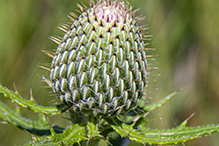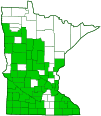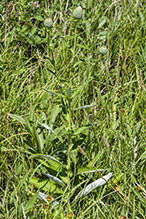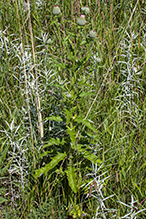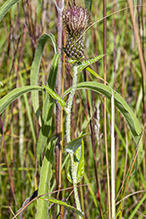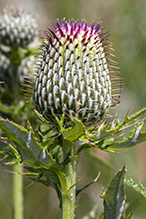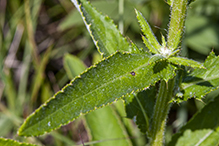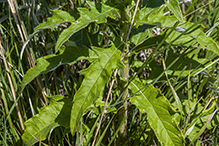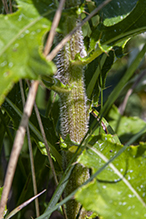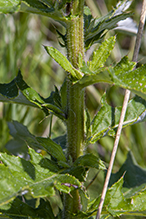tall thistle
(Cirsium altissimum)
Conservation • Description • Habitat • Ecology • Use • Distribution • Taxonomy
Conservation Status |
|
|||||||
| IUCN Red List | not listed |
|||||||
| NatureServe | N5? - Secure SNR - Unranked |
|||||||
| Minnesota | not listed |
|||||||
Description |
||
Tall thistle is an erect, robust, biennial or short-lived perennial forb that rises on a single stem from a slightly thickened taproot and fibrous roots. It occurs in the United States east of the Great Plains and in southern Quebec. In Minnesota it has a patchy distribution in the lower two-thirds of the state and is never common. It is absent from the far north and the Arrowhead region. It grows moderately moist to dry soil in full sun to light shade. It is found in prairies and fields; open woodlands; woodland edges, openings, and trails; railroads, roadsides, and disturbed sites. It is listed as a primary noxious weed in Iowa, but it has no weed status in Minnesota. It can be 40″ to 120″ tall but in Minnesota it is usually no more than 84″ in height. In its first year it appears as a radiating cluster (rosette) of leaves on the ground. In the second year a single flowering stem rises from the middle of the rosette. It dies after flowering once. The stem is erect, green, and usually unbranched below the inflorescence. It is usually sparsely to moderately covered with long, soft, shaggy hairs, and often has patches of white woolly hairs near the top. Sometimes it is almost hairless. It does not have spiny wings. The basal leaves are on long winged stalks (petioles). They are narrowly egg-shaped or inversely egg-shaped, tapered at the base, broadly angled or sometimes rounded at the tip, 4″ to 15¾″ long including the petiole, and 1½″ to 6″ wide. They are usually unlobed but sometimes they have a few deep lobes. The upper surface is hairless to moderately covered with straight, stiff hairs. The lower surface appears white due to a dense covering of short, soft, matted, woolly hairs. The margins have weak spines and may be toothed or wavy. Basal leaves are absent at flowering time. Stem leaves are stalkless, 1½″ to 10″ long, and ⅜″ to 5″ wide. They become gradually smaller as they ascend the stem. They may be unlobed or have broad, shallow lobes that extend less than half way to the midrib. They are narrowed at the base and sometimes partially surround (clasp) the stem. Stem leaves are otherwise similar to basal leaves. The upper leaves are well developed. The inflorescence is sometimes just a solitary flower head at the end of the stem. More often it is a single flower head at each branch tip. The flower heads are stalkless or on short stalks (peduncles). The peduncles are, up to 2″ long, have a few leaf-like modified leaves (bracts), and are not overtopped by upper stem leaves. There is not a ring bracts arching upward just below the flower head. The whorl of bracts at the base of the flower head (involucre) is egg-shaped to broadly cylinder- or bell-shaped, to 1″ to 1⅜″ (2.5 to 3.5 cm) long, and ¾″ to 1 3 ⁄16″ (2 to 3 cm) wide, as long or slightly longer than wide. The involucre has 10 to 20 series of strongly overlapping bracts (phyllaries) and often has cobwebby hairs. The outer phyllaries are egg-shaped, greenish, darker in the center, and tightly appressed. They have a narrow, milky white, sticky ridge on the midrib, and an abruptly and widely spreading, 1 ⁄16″ to 3 ⁄16″ (2 to 5 mm) long, straw-colored to light yellow spine at the tip. The flower heads are 1¼″ to 2″ wide and have 25 to 200 or more tubular florets. The petals (corollas) are pink to purple, rarely white. They are ¾″ to 1⅜″ (20 to 35 mm) long, are fused at the base into a ⅜″ to ⅝″ (10 to 16 mm) long tube, then separated into 5 spreading, ¼″ to ⅜″ (6 to 9 mm) long lobes. The flower heads are usually fragrant. The fruit is a tan to dark brown, ⅛″ to 3 ⁄16″ (4.0 to 5.5 mm) long capsule (cypsela). The cypsela has a straw-colored collar near the tip and a tuft of white or occasionally gray, ½″ to 15 ⁄16″ (12 to 24 mm) long hairs at the tip. |
||
Height |
||
40″ to 120″ |
||
Flower Color |
||
Pink to purple, rarely white |
||
Similar Species |
||
Field thistle (Cirsium discolor) leaves are deeply lobed, the lobes narrow and cut more than halfway to the midrib. The flower head is subtended by a ring of leaf-like bracts that arch upward . Flodman’s thistle (Cirsium flodmanii) is a shorter plant, usually no more than 32″ in height. The leaves are deeply lobed, the lobes narrow and cut more than halfway to the midrib. The stems remain densely white tomentose with age. The flower head is smaller, no more than 1″ wide. The collar on the cypsela is yellow and conspicuous. |
||
Habitat |
||
Moderately moist to dry. Prairies and fields; open woodlands; woodland edges, openings, and trails; railroads, roadsides, and disturbed sites. Full sun to light shade. |
||
Ecology |
||
Flowering |
||
Mid-July through September |
||
Pests and Diseases |
||
|
||
Use |
||
|
||
Distribution |
||||
|
Sources |
|||
| 6/27/2023 | ||||
Nativity |
||||
Native |
||||
Occurrence |
||||
Patchy distribution and not common in the lower two-thirds of the state, absent from the far north and the Arrowhead region |
||||
Taxonomy |
|||
| Kingdom | Plantae (Plants) | ||
| Subkingdom | Pteridobiotina | ||
| Phylum | Tracheophyta (Vascular Plants) | ||
| Class | Magnoliopsida (Dicots) | ||
Order |
Asterales (Sunflowers, Bellflowers, Fanflowers, and Allies) | ||
Family |
Asteraceae (Sunflowers, Daisies, Asters, and Allies) | ||
| Subfamily | Carduoideae (thistles and allies) | ||
| Tribe | Cardueae | ||
| Subtribe | Carduinae (thistles and burdocks) | ||
| Genus | Cirsium (plume thistles) | ||
Cardueae is a synonym of the tribe name. Cynareae was published first and has precedence. Nevertheless, most sources use the name Cardueae for the tribe. |
|||
Subordinate Taxa |
|||
|
|||
Synonyms |
|||
Carduus altissimus Cirsium altissimum var. biltmoreanum |
|||
Common Names |
|||
roadside thistle tall thistle |
|||
Glossary
Bract
Modified leaf at the base of a flower stalk, flower cluster, or inflorescence.
Clasping
Describing a leaf that wholly or partly surrounds the stem but does not fuse at the base.
Corolla
A collective name for all of the petals of a flower.
Cypsela
A dry, one-chambered, single-seeded seed capsule, formed from a single carpel, with the seed attached to the membranous outer layer (wall) only by the seed stalk; the wall, formed from the wall of the inferior ovary and also from other tissues derived from the receptacle or hypanthium, does not split open at maturity, but relies on decay or predation to release the contents.
Floret
An individual flower in a dense cluster of flowers; or a modified flower in the flower head in the Asteraceae family and some other families. In grasses, the modified flower in a spikelet of Poaceae and some Cyperaceae with its lemma and palea.
Involucre
A whorl of bracts beneath or surrounding a flower, flower head, or flower cluster.
Peduncle
The stalk of a single flower or flower cluster.
Phyllary
An individual bract within the involucre of a plant in the Asteraceae family.
Rosette
A radiating group or cluster of leaves usually on or close to the ground.
Wing
A thin, flat, membranous, usually transparent appendage on the margin of a structure.
The Native Thistle Test
Thistles native to Minnesota do not have spiny stems. Grasp the stem near the base of any native thistle loosely in your fist, then slide your fist upwards to just below the inflorescence. If the plant is a native thistle, you will not get a single prickle – it will be “ouchless”.
If the thistle in question is thought to be an exotic (non-native) species, this test is not recommended.
Tall thistle is native.

Slideshows |
||

Visitor Videos |
|||
Share your video of this plant. |
|||
| This button not working for you? Simply email us at info@MinnesotaSeasons.com. Attach a video, a YouTube link, or a cloud storage link. |
|||
Other Videos |
|||

Visitor Sightings |
|||||
Report a sighting of this plant. |
|||||
| This button not working for you? Simply email us at info@MinnesotaSeasons.com. Be sure to include a location. |
|||||
|
|||||
MinnesotaSeasons.com Sightings |
|||||

Created: 11/13/2019
Last Updated:
